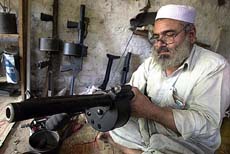Vital stats of the Mumbai siege operation
On 26th November, a Wednesday night, ten terrorists, (nine killed and one taken alive), mounted a terrorist strike in Mumbai. They attacked at least ten venues (Cama Hospital, Guru Tegh Bahadur Hospital, CST Train Terminus, Leopold Cafe, Girgaum Chowpatty, Metro Junction + the four buildings occupied) and later occupied four building complexes ((The Oberoi Trident Hotel; The old Taj Mahal Hotel and the new Taj;The Nariman Building), killed nearly 190 people over a space of nearly 60 hours. These terrorists came with machine guns, machine pistols, grenades, incendiary bombs, satellite phones, credit cards, Indian currency and US dollars, conflict rations of dry fruits like almonds, raisins, etc.

Indian commando On Nariman House, Mumbai
The assault on these terrorists, initially by local police and later by the elite NSG and MARCOS commando units spread over 60 hours, sanitized nearly a 1000 rooms, covered nearly 70 kilometres of passage ways, corridors, alcoves, enclosures, rooms and passages, in 4 building complexes, spread over nearly 1 square kilometre of dense urban population. Some 150 commandos were used - and final tally of defence personnel killed was 14 policemen and 3 commandos.

Jyoti Krishan Dutt
After this operation, crowds cheered and the commandos were surrounded by jubilant crowds. Indian media provided live coverage of this terrorist carnage with multiple cameras at multiple sites in a brilliant operation.
Israeli ‘experts’ were quick to condemn the Indian commando operation. Imagine the Israelis talking about collateral damage. ‘Experts’ carped about the total intelligence failure - whereas, it was clear that requisite intelligence information was drowned in the accompanying ‘noise’.
The aftermath
One day after the end of this operation, the Indian media and commentators are unanimous. Blame the politician.
The Times Of India, desperately somber, intones,
as heaps of bodies lie in morgues in a charred or decomposed state, and loved ones huddle outside to receive them one last time, it is time to ask our politicians: Are you going to go back to playing politics with our lives? Or are you going to do something worthwhile with yours? How many deaths will it take till you know that too many people have died?
Normally incisive, MJ Akbar, falls into the trap of blaming politicians.
The most significant part of the outrage should not be obscured by the drama of events hypnotized by attack, we should not become oblivious of defence. We have been defeated by incompetent governance, both in Mumbai and Delhi … Complacence and politics gave the terrorists more protection than silence or deception could. But ineffectual leadership turning a tough nation into a soft state. We should have been world leaders in the war against terrorists, for no nation has more experience Instead we are wallowing in the complacent despair of a continual victim. Some three years ago, Dr Manmohan Singh told George Bush that there were no terrorists among Indian Muslims. Perhaps he was unaware of the 1993 Mumbai bombings. Perhaps he want ed to please two constituencies: Bush, who needed a certificate for his view that democracy was the cure for all evil; and local Muslims, who were not being given jobs but could always be offered the consolation prize of a pat on the back. Dr Singh certainly did not fool any terrorists. The Lashkar-e-Taiba might even have interpreted such self-congratulation as a challenge.
Declares, Lord Baron Meghnad Desai,writing in the Indian Express,
It is a test of leadership.
Can India’s political parties, tested for 60 years in the crucible of democracy, rise to this occasion and save our country? Can we set aside partisanship of our politics and forge a united front? Can the two major parties set aside differences in their visions of India and weave a common narrative of why India is a nation, united and single?
Hindustan Times joins in with its own two bits. Inderji Hazra writes, in a very superior fashion,
Frankly, the ‘lack of form’ shown by our political class isn’t a big deal for me. The pre-poll mud-slinging looks bad. But so does the shit on our roads. What makes me break into a twitch is something beyond this beggar’s opera. When pundits talk about ‘asymmetrical warfare’, they never mean lathi-wielding policemen vs AK47-armed terrorists, do they? And aren’t patrols and security checks, whether along sea fronts or at the entries of malls too much of a drag to bother about day in, day out? As for bringing about more stringent anti-terror laws — or even following standard procedures of law and order and investigations — is it worth all that effort when only two things really determine how easy or hard it will be for future terrorists to attack us?
The two things: political meddling and the law of averages.
Before coming to conclusions about this attack, let us also look at some other incidents across the world in the last few years.
Global Benchmarks
On 23rd October 2002, at a theater in Moscow, the Nord-Ost incident, some 40-50 Chechnyan separatist “Special Purpose Islamic Regiment” took an estimated 850 people hostage. An estimated 300 Russians died in an attempted rescue - and 39 terrorists were killed. This entire operation took was completed after 3 days by releasing a deadly poison gas - that killed many more hostages than the terrorists.
On September 1st, 1995, again in Russia, in the Beslan school tragedy, more than 360 people were killed in the 1995 raid, purportedly led by the Chechen warlord Shamil Basayev, who escaped during the botched rescue attempt by troops. Basayev’s claims of responsibility for this attack on Beslan School Number One, are disputed. Basayev used a gang which turned out to be bigger than what Russian authorities initially claimed. An investigator, Mr. Torshin disputed the claim, posted on a Chechen website, saying it “could be a hoax”. Of the 32 hostage-takers, one was captured alive, 30 died and one was blown apart. And the number of time taken to ‘resolve’ this crisis was again about 3 days.
On 5th May, 1980. the ‘famous’ SAS rescued hostages from the Iranian embassy in London. On April 30th, 1980, six Iranian Arab gunmen, opposed to Ayatollah Khomeni, took hostages, demanding release of some nearly 100 Iranian political prisoners. After 5 days of planning, some 30 ‘crack’ SAS troops overran the embassy. Of the six gunmen, five were killed and one arrested. Of the twenty two hostages, ninteen were set free, one died and two injured in the cross-fire. A film was later made on this operation.
In Peru, the siege of the Japanese embassy began on 17 December when the Marxist rebels stormed a diplomatic cocktail party, seizing more than 400 guests as hostages. The Peruvian forces, with the help of the British SAS, took two weeks to plan this assault.On April 22nd, 1997, the hostages were finally released - after some 4 months.American FBI pitched in, claiming some credit for this operation.
In India, the Akshardham Temple attack took four days to clear.
Let us get real, shall we?
The Indian Government (Central and State together) have an employee base of about 55 lakhs. The number of elected representatives total around 5,500. The Indian population totals 110 crores (1100 million). It makes no sense to make scapegoats of 5500 politicians.
Blaming politicians, who are temporary office bearers, is escapist and is a well tuned strategy by the entrenched bureaucracy which bears the full responsibility for this - the success of this operation and the lack of efforts to kill this problem at its root.
Future Actions
India needs to act differently. India must work on three point agenda.

Pakistani tribesman makes a grenade launcher in the Darra Adam Khel tribal area, 47 km from Peshawar
One - Close down the Peshawar arms bazaar. This small time bazaar became the sourcing centre for terrorists all over the world. Initially, stocked up with arms from the CIA funded jihad against the Soviets in Afghanistan, Peshawar, has become a problem that never ends. If required, there should be a UN mandate to send in a multinational force to surround, capture and destroy this centre for arms and armaments.
Two - Withdraw all technology from Pakistan for all arms and ammunition. No RDX, no tanks, no F-16s, no APCs. Pakistan must be put on strict diet of military technology blockade by the world. No less.
Three - Secure Pakistan’s borders with a tripartite agreement between China, India and Pakistan which will guarantee Pakistan’s current borders. No disputes, no claims from Pakistan have any legitimacy any more. Let Pakistan take care of its current territory and people.
These three actions will rid the sub-continent of all tensions and conflicts - no less. It has to be underpinned by India and China. The West, and Pakistan will protest, but must be made to follow this prescription.













